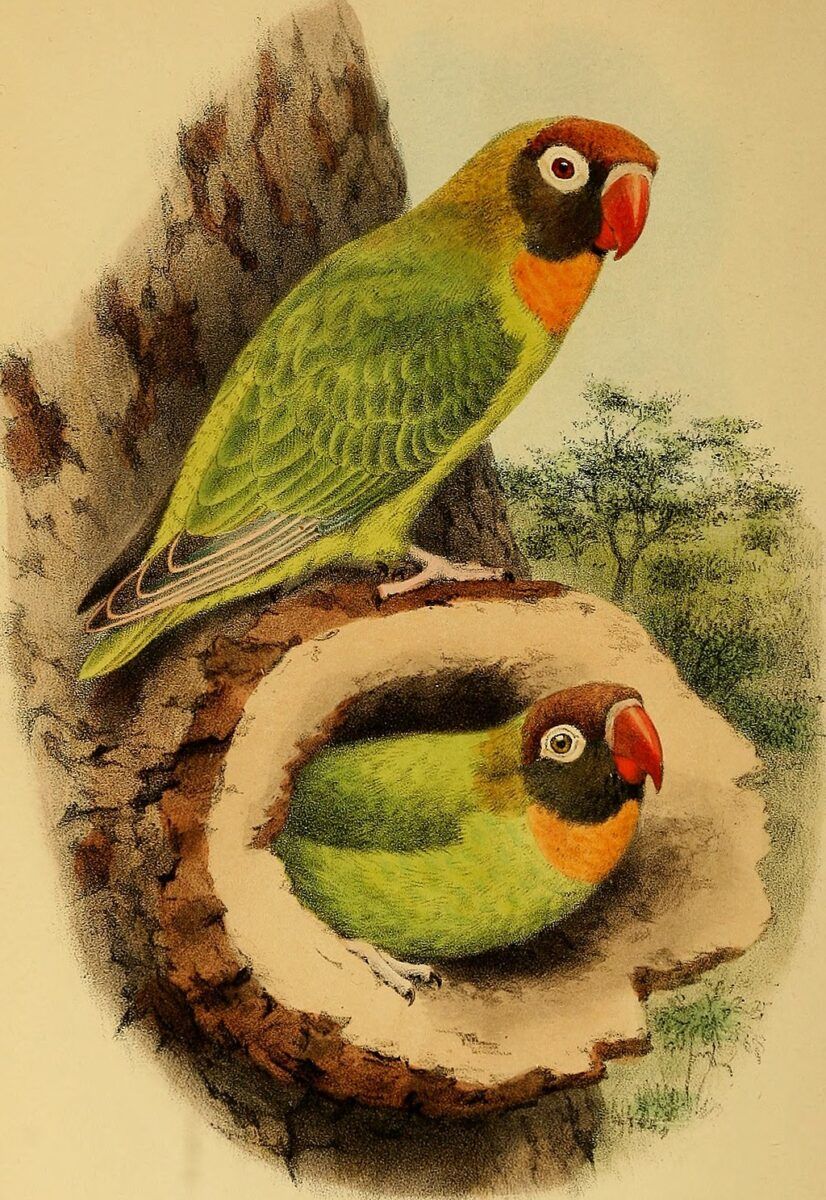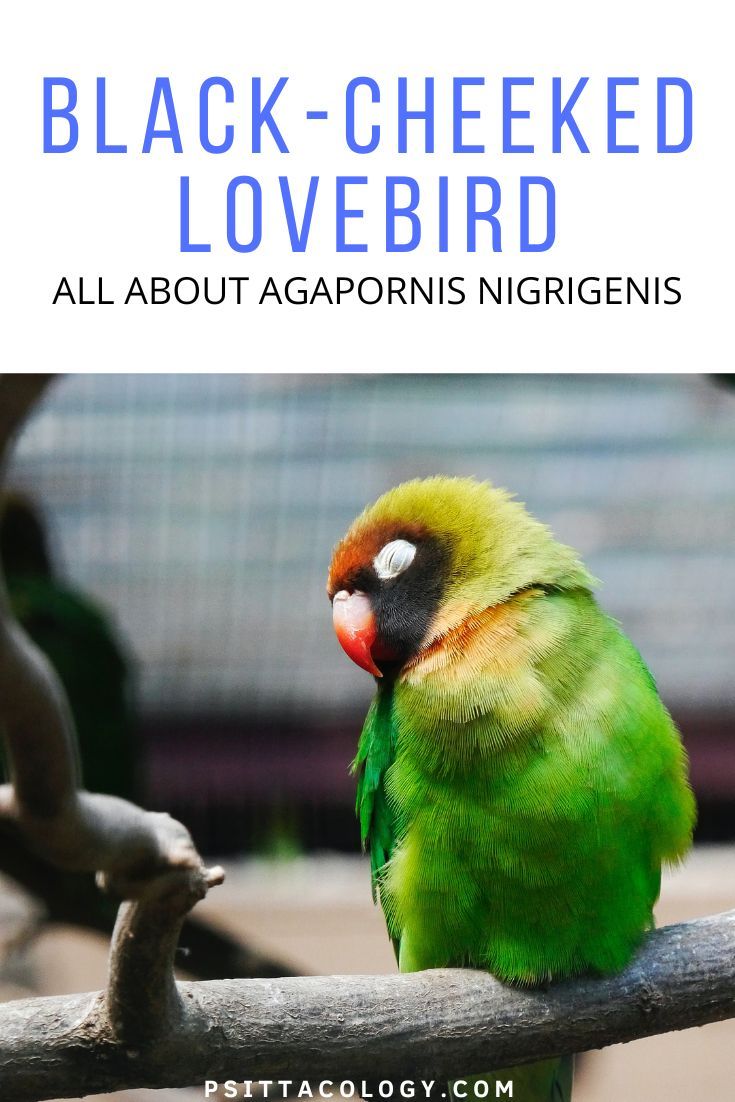The black-cheeked lovebird, scientifically known as Agapornis nigrigenis, is a fascinating and colorful bird species native to southern Africa. Despite its charming personality and eye-catching looks, this lovebird isn’t commonly seen in aviculture.
Below, let’s dive into what makes the black-cheeked lovebird stand out among other Agapornis species. Keep reading to discover how to recognize this small parrot, find out more about its diet and behavior, and learn why it’s not as commonly kept as a pet as other lovebirds.
| Name(s) (common, scientific) | Black-cheeked lovebird, Agapornis nigrigenis (incorrectly: Agapornis lilianae nigrigenis*) |
| Natural habitat | Zambia |
| Adult size | Up to 14 cm (5.5″) & between 40–45 grams |
| Lifespan | 15-20 years average |
| Noise level | Medium |
Black-cheeked lovebird appearance
The black-cheeked lovebird (Agapornis nigrigenis) is a small parrot species, measuring only about 13-15 cm in length and weighing up to 45 grams. Like many other parrots, this species is very colorful, with vivid green plumage on most of the body and wings.
The brown eyes are surrounded by white eye-rings, making them part of the “eye-ring” group of lovebirds (along with the yellow-collared lovebird, Fischer’s lovebird and Lilian’s lovebird).
True to their name, these birds do indeed have a blackish-brown patch on their cheeks and forehead, almost like a mask. They’re easy to recognize by the orange patch beneath the throat, something no other lovebird species has. Their beaks are bright red.
It’s not really possible to visually sex a black-cheeked lovebird, as the males and females sport similar colors. Juvenile birds have more muted green feathers, which brighten as they age and molt into their adult plumage. Their beaks are also initially more orange-toned, gradually transitioning to red as they mature.

Black-cheeked lovebird range & natural habitat
Range
Black-cheeked lovebirds are native to a tiny region in southern Africa, specifically (southwestern) Zambia.
It’s thought they may also pop up in nearby Botswana, Zimbabwe and Namibia, but this doesn’t seem to happen very often, at least not anymore. Some sources suggest their natural range was wider in the past.
Natural habitat
In their natural habitat, black-cheeked lovebirds prefer areas of scrubland, thornbush, savanna, and woodland ecosystems. They’re most common in mopane and Acacia woodland, which is characterized by Colophospermum mopane and Acacia sp. trees.
These parrots are usually found near water sources, such as rivers or wetlands, where they feed on seeds like Acacia and can gather plenty of nesting material when the breeding season sets in. They build nests in mopane tree hollows or termite mounds and form monogamous pairs.
Agapornis nigrigenis is known for its sociable nature – they’re called lovebirds for a reason! Individuals use a variety of behaviors to communicate with each other, including a range of different calls and vocalizations, head-bobbing, and preening.
Typically, these birds form small flocks consisting of up to 20 birds. However, during the dry season, they can gather in much larger flocks, sometimes over 800 birds strong.

Threat level
At the time of writing, the IUCN Red List Threatened Species last assessed the black-cheeked lovebird in 2016. It has unfortunately been listed as ‘Vulnerable’, with the population appearing to be in decline. It’s suspected there are less than 10,000 of these birds left.
Although the pet trade and trapping are considered major threats to wild Agapornis nigrigenis populations, the main problem appears to be habitat desiccation and the disappearance of permanent water sources.
As a result of irresponsible land management and farming practices, as well as climate change, the species’ natural habitat is getting drier.
Black-cheeked lovebird diet
This lovebird finds its food mainly at ground level. Its favorite foods are various species of grass seeds, although it’ll also consume small insects, young leaves, flowers and buds, and any other edible morsels it can find.
To local farmers’ dismay, black-cheeked lovebirds do have a taste for common crops. They’ll happily feast on plants like millet, corn and sorghum. As a result, like many other parrot species, they’re sometimes considered pests in their natural range!
If you’ve managed to obtain a pet black-cheeked lovebird, you can feed it a varied diet of high-quality parrot pellets, a good seed mix and a variety of vegetables and fruits. You can check out out the article on parrot diet for more info about what to feed these birds.

Black-cheeked lovebird as a pet
Unlike some other species of lovebirds, particularly the peach-faced lovebird (Agapornis roseicollis), the black-cheeked lovebird is not commonly kept as a pet or bred in aviculture.
Despite its charming personality and stunning appearance, this species remains relatively rare in captivity, with limited availability in the pet trade. After all, the trapping of wild birds has long been illegal, and breeders have long had difficulty expanding the captive population.
In any case, given the species’ highly vulnerable status, I think we can agree that it’s best to focus on conservation rather than keeping black-cheeked lovebirds as pets. Breeding programs should be the priority!
Black-cheeked lovebird sounds
The calls and vocalizations of the black-cheeked lovebirds are an important part of their social behavior and communication. As with other lovebirds, flock calls are pretty loud and piercing.
Aside from this, Agapornis nigrigenis produces a variety of sounds, including chirps, tweets, squawks and screeches (alarm calls) and whistles. Like other parrots, they can also pick up and imitate sounds from their environment.
If you’d like to have a listen, you can do so over at xeno-canto.
If you have any more questions about the black-cheeked lovebird or if you’d like to share your own experiences with this rare parrot, don’t hesitate to leave a comment below!
Sources
Black-cheeked Lovebird (Agapornis nigrigenis) – BirdLife species factsheet. (n.d.). Datazone.birdlife.org. Retrieved April 15, 2023, from http://datazone.birdlife.org/species/factsheet/black-cheeked-lovebird-agapornis-nigrigenis/text
https://www.iucnredlist.org/species/22685360/93069915
Parr, M., & Juniper, T. (2010). Parrots: a guide to parrots of the world. Bloomsbury Publishing.
